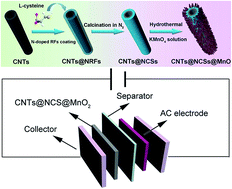Hierarchical porous CNTs@NCS@MnO2 composites: rational design and high asymmetric supercapacitor performance†
Abstract
In this contribution, we present a novel and rational strategy for preparing hierarchical porous CNTs@NCS@MnO2 core–shell composites via a facile in situ chemical polymerization coating method, followed by a hydrothermal process. An intermediate nitrogen-doped carbon shell (NCS) with mesoporous structure and favorable chemical durability is obtained by utilizing resorcinol–formaldehyde resin as the carbon source and L-cysteine as the nitrogen source. Benefiting from a unique structure and considerable combination, the composites exhibit a highly comprehensive electrochemical performance: high specific capacitance (312.5 F g−1 at a current density of 1 A g−1), good rate capability (76.8% retention with the charge–discharge rate increasing from 1 A g−1 to 10 A g−1), superior reversibility and cycling stability (92.7% capacitance retention after 4000 cycles at 8 A g−1). In order to increase the energy density and voltage window, an asymmetric supercapacitor (ASC) was assembled using CNTs@NCS@MnO2 and activated carbon (AC) as the positive and negative electrodes, respectively. The as-fabricated asymmetric supercapacitor achieved a high specific capacitance with a stable operating voltage of 1.8 V and a maximum energy density of 27.3 W h kg−1. Such a synthetic route to prepare capacitor materials can thoroughly motivate the synergistic effect between electrical double layer capacitors and pseudocapacitors for obtaining high comprehensive performance electrodes in energy storage fields.


 Please wait while we load your content...
Please wait while we load your content...